The Pro Six Step Baseball Swing
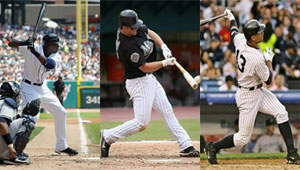
At BeABetterHitter (BABH) we have learned that the easiest way to teach young players the baseball swing is to break the swing down into parts. Elsewhere on this site you will find the 6 Steps to a Sweet Swing and other articles that refer to this approach.
As complex as the baseball swing can be, it can also be quite simple. If you ingrain the six step sequence into muscle memory, your task of hitting becomes much easier. The swing becomes automatic. In other words, you don’t have to do anything but pick out a good pitch to hit… then hit it. With a good swing as part of your arsenal when you get in the batter’s box, you increase your odds for success against those pesky pitchers who seem to have nothing better to do than figure out ways to send you back to the dugout.
It never fails; even though we have seen continued success in hitters that develop their swings with this method… there are always nay-sayers that pooh-pooh this philosophy. So, we decided we would break down the swing of some Major League players and demonstrate that they too have 6 steps ingrained in their swings: 1. Load 2. Step 3. Launch 4. Contact 5. Extend 6. Extend Again.
I want you to realize that we are not including the stance or the finish in these 6 steps. The stance is a matter of style, body type and other factors. There are as many stances as there are hitters. Stand any way you want. But, I will say… a fundamentally sound stance will afford you the best opportunity to get the six step swing in sequence and have greater success at the plate. So, some extravagant stance will require some extraordinary skill to get the bat to the contact point. A clean, simple, fundamentally sound stance tends to promote a short, powerful, accurate and repeatable swing. Since that’s what we aim for at BABH, consider keeping it simple.
The finish is generally a by-product of the swing up to and through the 6th step, what area of the strike zone the pitch was connected with, as well as a player’s body type. Therefore, we don’t really harp on this much either. We do demand that a player pay attention to his balance at the finish of his swing. During drills, soft toss, and cage work a player should have a degree of attention on his balance at the conclusion of the swing. This only helps in developing the short, powerful and accurate swing that we aim for. Keep that in mind when you are developing your swing.
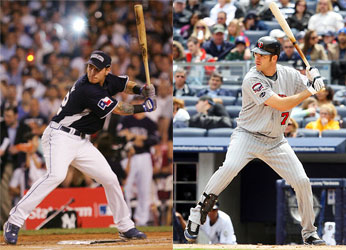 Step 1: The Load
Step 1: The Load
Its Purpose: store energy to release into the ball.
At BABH we advocate a slight lifting of the front heel and a slight turn in of the front knee. This effectively and efficiently transfers enough weight to the back side and prepares the “coil”. Power comes from the ground up so be sure and keep the transferred weight on the “inside” of the rear foot, calf and thigh. You will need it there so that it can be used properly in the next sequence.
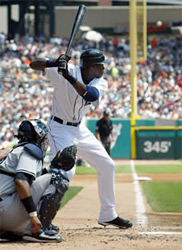 Step 2: The Step
Step 2: The Step
Its Purpose: Time the pitch properly and “set” the coil, or “trap” the weight.
Here you can see Cameron Maybin taking his stride. He has a steady head, directly over the lead shoulder. His hands are back and waiting to identify the “third of the plate” location of the incoming pitch. You definitely want to get your stride down in time for the pitcher’s fastball. This allows you time to react to the speed and the location. If your foot is down late, you are vulnerable. The step should be “short”, “soft” and straight to the ball. We like to see a slightly open front foot. It allows a quicker and more powerful release of the rear hip.
The below picture is a good indication of when you should have the front foot down. You should also be identifying which third of the plate you need to attack by this point.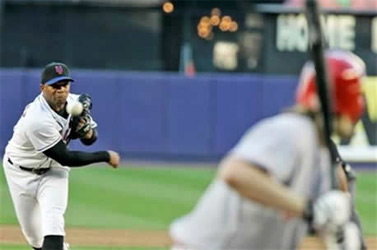
 Step 3: The Launch
Step 3: The Launch
Its Purpose: to uncoil the power we stored up during the first two steps of the swing. Notice that the hands have not committed to release the bat yet. They are allowing the ball to travel deeper into the zone before making the commitment to the contact point. But!! They have already lined up with the plane of the incoming pitch, this is the result of the bottom hand. Driving the knob of the bat to the ball with the bottom hand (pulling) is the ideal way to imbed this muscle memory in your swing. The bottom hand guides the bat barrel into the proper slot as you see here.This also sets the “tilt” in the upper body. Critical for proper bat path alignment with the incoming pitch. Also notice the “open” front foot.
Both of these swings resulted in home runs. Check out the bat lag in the swing, the firm front side and the commitment of the rear hip into the swing. The hips have launched! The hips lead the hands in a baseball swing, remember that. The head is steady and the eyes are completely locked on to the baseball with a singular focus… hit the ball! Build a good swing, then simply “See it. Hit it!”
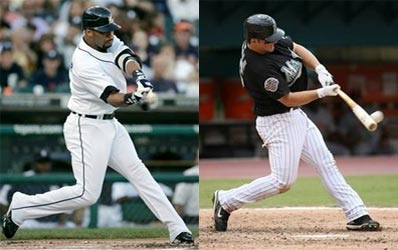 Step 4: Contact
Step 4: Contact
Its Purpose: hit the ball hard somewhere! Two more home runs here. Notice here that Sheffield is hammering down on the ball imparting backspin while Dan Uggla is on a completely different plane and launching the ball to left field. Guess what, this is partly due to their recognition of what third of the plate they were going to make contact at! It is also partly due to the trajectory of the pitch. Notice the incredible similarity in the front side, the front foot is angled, backside is completely rotated. The power they generated during the coil and uncoil is released into the ball. The top hand is palm up and “pushing” while the bottom hand is palm down and “pulling”! The right elbow is still bent and delivering a blow much like a body punch from a boxer at close range. Also, the balance here is incredible. This allows a complete release and rotation of the backside into the ball. The barrel of the bat is basically “pivoting” around the stationary axis (the firm front side).
Step 5: Extend
Its Purpose: Continue to transfer energy through the contact of the ball. This allows the speed of the bat to continue to accelerate (XLR8) past the contact point. It’s here that the back elbow starts to straighten out as a result of the “pushing” from the top hand.
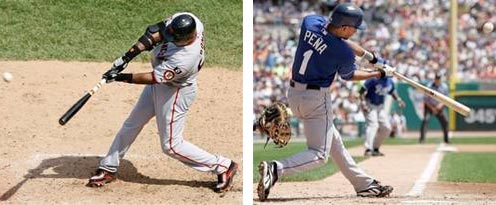 Remember the preaching that you get from BABH: Be short to the ball and long through the ball! This is the start of the “long through the ball”. Do not slow down the bat after contact! Let it continue through the ball! You can see that the wrists have not quite rolled yet.
Remember the preaching that you get from BABH: Be short to the ball and long through the ball! This is the start of the “long through the ball”. Do not slow down the bat after contact! Let it continue through the ball! You can see that the wrists have not quite rolled yet.
Step 6: Extend Again
In fact, in our pursuit of the “long through the ball” concept, we want our players to “extend again”. Here you can see Major League hitters employing that concept until they reach the “Power V” position that is so often referred to.
Notice that the head stays in line with the rear shoulder, almost like using it as a sight through which to view the ball. This is a result of the “rotating under a steady head” rule that we like to enforce. The wrists are beginning to roll which allows the bat to release into the finish.
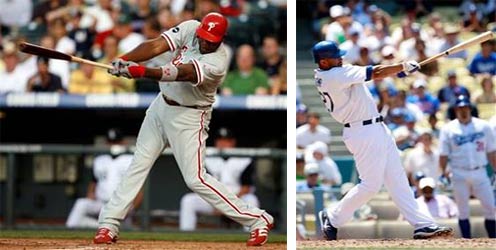
Speaking of The Finish, here are some examples of different styles. Again, these are a combination of body type, location where the pitch was struck and personal style.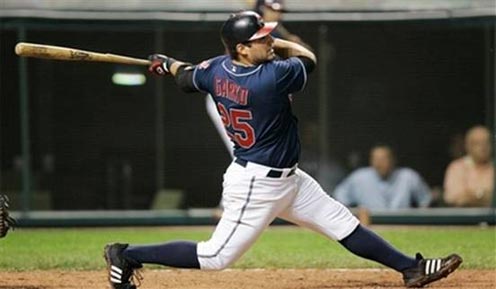
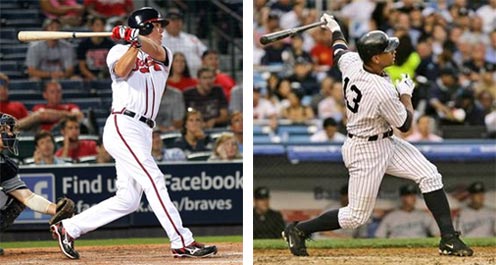
And don’t let yourself forget that the idea is to “let the ball travel” whenever possible. Like when the ball is on the outer two thirds of the plate. Let it travel so you can hammer the inside of the ball. The saying “keep your hands inside the ball” is there for a reason. This has been the mantra of good hitters since the days of Ty Cobb. Here’s an example of what they are talking about.
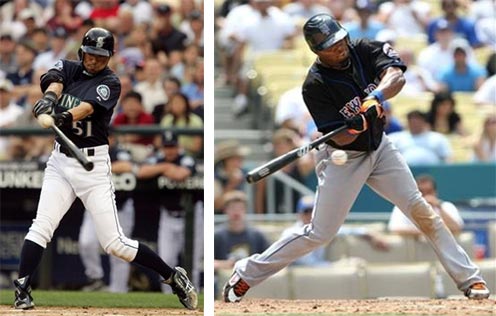
Notice that these two points of contact are just about middle of the body and deeper! That’s allowing the ball to travel, knowing and trusting your swing and having a single minded purpose: hit the ball hard somewhere! Remember, most pitches are on the outer two thirds of the plate. If you let the ball travel you can use the big part of the field and that helps you to Be A Better Hitter!
by Buz Brundage

the purpose of the load is to help with timing.
Thank you for this consice and straight forward article. As a former college player, little league coach, and having a son who plays on a competitive 12U team, I recommend your approach.
Your approach is sound as to mechanics and easy to teach. It’s worth a review by Dad’s, coaches, and players. You need a BABH patch to wear on a uniform.